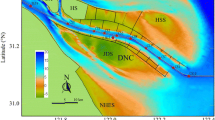Abstract
We describe the tidal circulation and salinity regime of a coastal plain estuary that connects to the ocean through a flood tide delta. The delta acts as a sill, and we examine the mechanisms through which the sill affects exchange of estuarine water with the ocean. Given enough buoyancy, the dynamics of tidal intrusion fronts across the sill and selective withdrawal (aspiration) in the deeper channel landward appear to control the exchange of seawater with estuarine water. Comparison of currents on the sill and stratification in the channel reveals aspiration depths smaller than channel depth during neap tide. During neap tide and strong vertical stratification, seawater plunges beneath the less dense estuarine water somewhere on the sill. Turbulence in the intruding bottom layer on the sill promotes entrainment of fluid from the surface layer, and the seawater along the sill bottom is diluted with estuarine water. During ebb flow, salt is effectively trapped landward of the sill in a stagnant zone between the aspiration depth and the bottom where it can be advected farther upstream by flood currents. During spring tide, the plunge point moves landward and off the sill, stratification is weakened in the deep channel, and aspiration during ebb extends to the bottom. This prevents the formation of stagnant water near the bottom, and the estuary is flooded with high salinity water far inland. The neapspring cycle of tidal intrusion fronts on flood coupled with aspiration during ebb interacts with the sill to play an important role in the transport and retention of salt within the estuary.
Similar content being viewed by others
Literature Cited
Andrade, F. A. 1986. O estuário do Mira: caracterização geral e análise quantitativa da estrutura dos macropovoamentos bentónicos. Ph.D. Dissertation, University of Lisbon, Lisbon, Portugal.
Andrade, F., M. Reis, andP. Duarte. 1991. The dynamics of the tide excursion in the Mira Estuary (Vila Nova de Milfontes, Portugal). A Lagrangian approach, p. 49–55.In M. Elliott and J. P. Ducrotoy (eds.), Estuaries and Coasts, Spatial and Temporal Intercomparisons. Olsen and Olsen, Fredensberg, Denmark.
Armi, L., andD. M. Farmer. 1986. Maximal two-layer exchange through a contraction with barotropic net flow.Journal of Fluid Mechanics 164:27–51.
Blanton, J. O., K. R. Tenore, F. Castillejo, L. P. Atkinson, F. B. Schwing, andA. Lavin. 1987. The relationship of upwelling to mussel production in the rias on the western coast of Spain.Journal of Marine Research 45:497–511.
Cannon, G. A. 1969. Observations of Motion at Intermediate and Large Scales in a Coastal Plain Estuary. Technical Report 52, Chesapeake Bay Institute, Johns Hopkins University, Baltimore, Maryland.
Farmer, D. M. andL. Armi. 1986. Maximal two-layer exchange over a sill and through the combination of a sill and a contraction with barotropic flow.Journal of Fluid Mechanics 164: 53–76.
Fischer, H. B., E. J. List, R. C. Y. Koh, J. Imberger, andN. H. Brooks. 1979. Mixing in Inland and Coastal Waters. Academic Press, New York.
Helfrich, K. R. 1995. Time-dependent two-layer hydraulic exchange flows.Journal of Physical Oceanography 25:359–373.
Instituto Hidrográfico. 1997. Tabela de Marés: 1998. Instituto Hidrográfico, Lisbon, Portugal.
Largier, J. L. 1992. Tidal intrusion fronts.Estuaries 15:26–39.
Largier, J. L., J. H. Slinger, andS. Taljaard. 1991. The stratified hydrodynamics of the Palmiet—A prototypical bar-built estuary, p. 135–153.In D. Prandle (ed.). Dynamics and Exchanges in Estuaries and the Coastal Zone. American Geophysical Union, Washington, D.C.
Nunes, R. A. andJ. H. Simpson. 1985. Axial convergence in a well-mixed estuary.Estuarine, Coastal and Shelf Science 20:637–649.
Officer, C. B. 1976. Physical Oceanography of Estuaries (and Associated Coastal Waters). John Wiley and Sons, New York.
Proudman, J. 1953. Dynamical Oceanography. Methuen, New York.
Seim, H. E. andM. C. Gregg. 1997. The importance of aspiration and channel curvature in producing strong vertical mixing over a sill.Journal of Geophysical Research 102:3451–3472.
Simpson, J. H. andR. A. Nunes. 1981. The tidal intrusion front: An estuarine convergence zone.Estuarine, Coastal and Shelf Science 13:257–266.
Stommel, H., H. Bryden, andP. Mandelsdorf. 1973. Does some of the Mediterranean outflow come from great depth?Pure and Applied Geophysics 105:879–899.
Wooster, W. S., A. Bakun, andD. R. McLain. 1976. The seasonal upwelling cycle along the eastern boundary of the North Atlantic.Journal of Marine Research 34:131–141.
Author information
Authors and Affiliations
Corresponding author
Rights and permissions
About this article
Cite this article
Blanton, J.O., Ferreira, M.A. & Andrade, F.A. Effect of a broad shallow sill on tidal circulation and salt transport in the entrance to a coastal plain estuary (Mira—Vila Nova de Milfontes, Portugal). Estuaries 23, 293–304 (2000). https://doi.org/10.2307/1353322
Received:
Accepted:
Issue Date:
DOI: https://doi.org/10.2307/1353322




